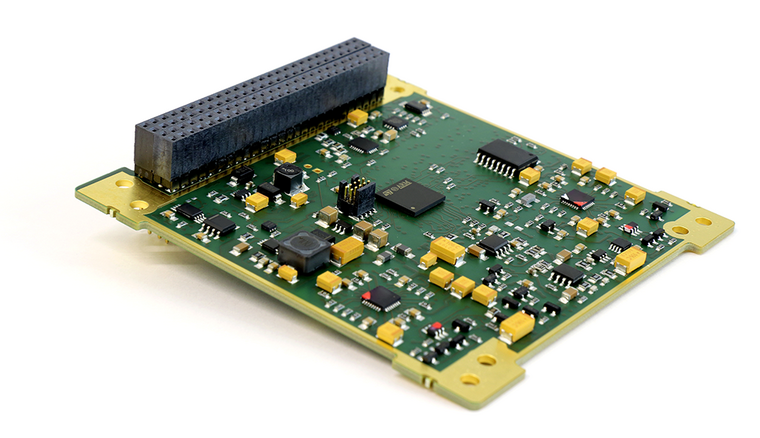SATDOS Reference Dosimeter Platform
SATDOS is a miniaturized payload designed for nano-satellites, such as CubeSats, aiming to capture the radiation environment in space and quantify radiation effects on electronic systems. Developed by Seibersdorf Laboratories with cutting-edge technology and expertise, SATDOS offers a simple and reliable solution for capturing radiation data in orbit. With multiple successful deployments and several versions in development, SATDOS continues to contribute valuable insights into the space radiation environment for commercial, scientific, and educational missions.
SATDOS Reference Dosimeter Platform for nanosatellites, engineered to monitor and evaluate the impact of space radiation on spacecraft electronic systems. The image showcases SATDOS for PRETTY, a specialized version tailored for the ESA PRETTY mission, which successfully operated in orbit and collected valuable radiation data essential for assessing space environment effects.
Key Functions of SATDOS
- Assessment of Total Ionizing Dose (TID): SATDOS accurately measures the accumulated radiation dose received by a satellite over its mission duration. Understanding the Total Ionizing Dose is essential for evaluating the long-term radiation effects on electronic components, ensuring their reliability and helping to design radiation-hardened systems. This capability is critical for spacecraft performance and safety, especially in missions traversing high-radiation environments such as the Van Allen Belts or during solar storms.
- Continuous Dose Monitoring: SATDOS enables real-time radiation dose rate monitoring throughout a satellite's orbit. By continuously collecting radiation data, it provides comprehensive mapping of Earth's radiation environment, including areas of increased exposure, such as the South Atlantic Anomaly (SAA). This data reveals the temporal and spatial characteristics of space weather and supports timely responses to events such as solar particle eruptions.
- Detection of Single Event Effects (SEE): SATDOS detects Single Event Effects (SEE), which are caused by high-energy particles impacting electronic components, potentially causing malfunctions or failures. One critical SEE type is the Single Event Upset (SEU), where a particle alters the state of a memory cell in an electronic device. SATDOS employs commercial SRAM (Static Random Access Memory) chips, which are characterized for radiation sensitivity. By using multiple SRAM types, SATDOS can distinguish between particles of different energy levels. This feature is key to evaluating radiation resilience of satellite electronics and contributes to the development of more robust spacecraft systems.
Space Radiation Environment
The space environment is rife with radiation hazards emanating from various sources. The sun emits charged particles, whose intensity can be significantly amplified during solar activities, posing a direct threat to spacecraft and astronauts. Additionally, galactic cosmic particles incessantly bombard spacecraft and astronauts during space travel. Charged particles trapped in Earth's magnetic field create the Van Allen radiation belts, posing risks to spacecraft traversing or approaching these regions.
Effects of Space Weather
Space weather events, such as solar storms and solar particle eruptions, can damage or impair electronic systems aboard satellites and spacecraft. A better understanding of space weather aids in the development of protective measures, enhancing spacecraft operation safety. Radiation resistance testing of satellite components is essential for mission reliability and safety. Seibersdorf Laboratories conducts radiation resistance tests as a commercial service for the Austrian and international space industries, developing experimental and numerical methods to investigate radiation effects on components and systems in diverse radiation fields. With their expertise and experience, Seibersdorf Laboratories' experts significantly contribute to the success of national and international space missions.
Conclusion
Understanding and mitigating the effects of space radiation are critical to ensuring the safety, reliability, and longevity of satellites and space missions. The SATDOS Reference Dosimeter Platform offers a flexible and adaptable solution for radiation monitoring across various CubeSat platforms and mission types.
Whether deployed for scientific research, technology validation, or educational projects, SATDOS delivers precise radiation data in real time, supporting mission success in diverse environments — from Low Earth Orbit (LEO) to radiation-intensive regions, such as the Van Allen Belts. Its versatile design ensures that future missions can navigate the challenges of the space radiation environment with confidence, contributing to safer and more resilient spacecraft systems.
Interested in SATDOS for your satellite?
Contact us to discuss how SATDOS can be integrated into your satellite project and provide valuable insights into the radiation environment of your mission.

